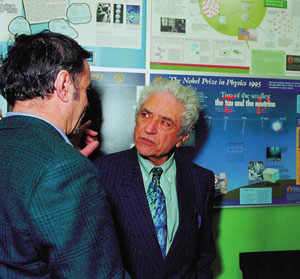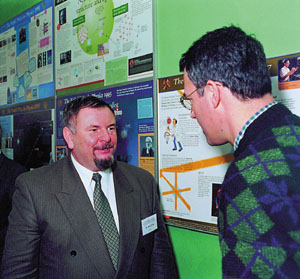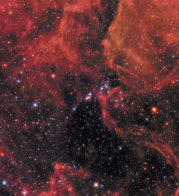Neutrinos were the subject of an annual conference held in Poland in January.


Neutrinos always provide compelling physics. An example of this occurred earlier this year on 7-9 January, just after the Epiphany holiday, when more than 150 high-energy and nuclear physicists and astrophysicists from many countries met in Cracow, Poland, for the Epiphany Conference on Neutrinos in Physics and Astrophysics, which is organized jointly by the Institute of Nuclear Physics and the Jagellonian University of Cracow. First held in 1995, these January Cracow meetings have now become an established feature of the international physics calendar.
Never lacking anyway, neutrino interest has been boosted by new evidence for neutrino oscillations – neutrino species (electron, muon and tau), long thought to be distinct and immutable, transform into each other. As well as surveying the experiments that led to this realization, the conference looked forward to new and planned experiments to investigate this new phenomenon further.
Of special interest are the long-baseline studies, in which neutrinos produced by an accelerator beam are observed by detectors installed at a distant point, typically several hundred kilometres away, for a direct measurement of neutrino oscillations. These manifest themselves either by the disappearance of the neutrino species produced at the accelerator site or by the appearance of a different neutrino species, depending on the capabilities of the detector installed.
One such project, K2K in Japan, which uses the neutrino beam produced at KEK and detectors of the Super Kamiokande neutrino observatory, has just started operation. The status of this experiment and recent data on solar and atmospheric neutrinos from Super-Kamiokande were presented in Cracow by Danuta Kielczewska (Warsaw). Results on the neutrino masses and mixing from other ongoing experiments were discussed by Jochen Bonn (Mainz), Yves Declais (Annecy) and Jonny Kleinfeller (Karlsruhe).
Two planned experiments, designed to use neutrinos produced at CERN and the detectors installed in the Grand Sasso tunnel in Italy, the ICANOE and the OPERA projects, were described by Andre Rubbia (Zurich) and Stavros Katsanevas (Lyon) respectively. Adam Para (Fermilab) summarized US neutrino experiments including the MINOS project, the 730 km baseline experiment using neutrinos from Fermilab, while Rob Edgecock (Rutherford Appleton) discussed the potential use of future muon colliders for super-long-baseline neutrino experiments.
Theoretical aspects were covered by Harald Fritzsch (Munich), who discussed potential connections between quark and neutrino mixings, Ferruccio Feruglio (Padova), who reviewed existing theories, and Marek Zralek (Katowice), who discussed the experimental constraints for Dirac neutrinos. The theory of unification and evolution of the neutrino masses was discussed by Stefan Pokorski (Warsaw) and Smaragda Lola (CERN).
On the subject of neutrinos in astrophysics, Wojciech Dziembowski (Warsaw) discussed the tests of the Standard Solar Model and production of solar neutrinos, Edwin Kolbe (Basel) talked about neutrino-nucleus interactions in stars, Henryk Wilczynski (Cracow) presented the neutrino aspect of the Pierre Auger cosmic-ray experiment and Anna Stasto (Cracow) discussed the penetration through the Earth of super-high-energy neutrinos.
The conference was summarized by 1988 Nobel laureate Jack Steinberger (CERN), who recalled the milestones of neutrino physics.
The first Cracow Epiphany Conference, in January 1995, was dedicated to Kacper Zalewski, one of the most creative and influential Cracow theoretical particle physicists, in honour of his 60th birthday. The subject was the physics of heavy quarks, one of Zalewski’s main fields of research. The success of that meeting encouraged Marek Jezabek, longtime Zalewski collaborator and (since last year) his successor as Head of Particle Theory Department of the Institute of Nuclear Physics in Cracow, to start a tradition. The idea was to change the subject of the conference every year and to attract the whole community of Cracow particle physicists working at the Jagellonian University, at the Institute of Nuclear Physics and at the Technical University of Mining and Metallurgy.
In 1996 the conference topic was proton structure, followed by W boson physics in 1997, the spin effects in particle physics in 1998 and electron-positron colliders in 1999.
The next Cracow Epiphany Conference, to be held on 5-7 January 2001, will cover b physics and CP violation. Further information is available from “epiphany@ifj.edu.pl”.





